Illinois’ Chris Barkan and RailTEC Convey the Message: “Trains—They Run on 'STEAM' and They're Terrific!”
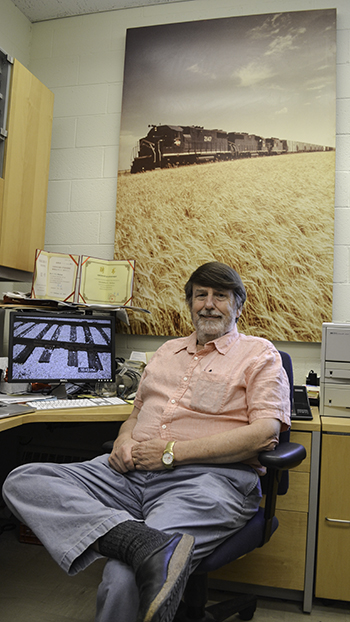
Chris Barkan, RailTEC Executive Director
August 22, 2016
Chris Barkan, a Professor in Civil and Environmental Engineering, is passionate about trains. He knows about railroad technology and history—both in America and elsewhere in the world. Here at Illinois, he leads RailTEC, the Rail Transportation and Engineering Center, a world-class railroad research and educational program studying ways to make trains safer, faster, and more efficient— environmentally, economically, and energy-wise. Barkan is also devoted to educating the next generation of railway engineering professionals. And to make sure that railroads (and RailTEC) have a steady supply of bright young students, he, along with his colleague, Tyler Dick, and their rail engineering students teamed up with Angela Nelson at Next Generation School's STEAM Studio to organize and host STEAMvention 2016, where they used the fascinating and fun aspects of railroads to attract youngsters to a journey on the STEM pipeline.
America's first railroads began in the 1820s, and by the end of the 19th Century, the network had grown to connect nearly all the cities in the US and Canada. Before railroads, a journey across the continent took many months, but by the dawn of the 20th Century, railroad passengers could travel coast to coast in mere days. Where have all the passenger trains gone? While high-speed trains have kept Europe’s passenger rail industry booming, outside the Northeastern US, we don’t use trains as much here. Why? America’s love affair with the automobile spawned the growth of a government-funded network of interstate highways across its wide open spaces and nearly caused the demise of passenger trains. “Cheap fuel and highways made it easy and convenient for people to use their cars,” says Barkan.
So, based on the number of semi’s we pass when driving on the interstate, will America’s freight soon be obsolete too? Barkan says no.
“It’s actually the opposite…This is a common misunderstanding. Passenger rail has declined significantly, however freight rail has continued to thrive.” In fact, since the deregulation of railroads in 1980, “Railroads are hauling more freight than ever in history,” he explains, adding, "A much larger fraction of America’s freight is transported by rail than truck,” providing America with a variety of environmental, energy, and economic benefits. "Ironically, Europe, looks with envy at our efficient freight rail system, much as we admire their high-speed passenger trains," says Barkan.
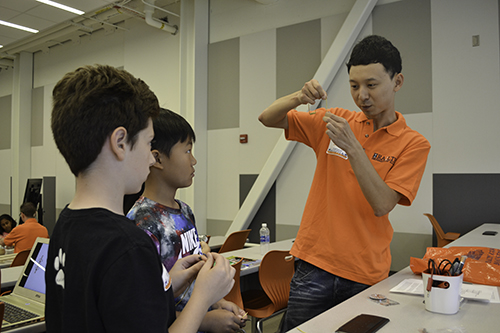
RailTEC graduate student Siyao Luan (right) explains electromagnetism to a couple of STEAMvention students.
“As we have come to understand the importance of energy efficiency," Barkan continues, "railroads have a lot to offer. Trains are about four times more efficient than trucks. And, a corollary benefit is that they produce fewer emissions and use less land. This is part of the reason why there has been a resurgence in rail freight in the US.”
And Illinois’ research has contributed to trains' environmental and economic efficiency: According to Barkan, there has been "more and more focus on building smarter, stronger infrastructure that can support heavier loads and higher speeds to take greater advantage of railroad economies of scale. The bigger the railcar, the longer the train, the more efficient it is. So in addition to their energy and environmental efficiency, they are also more economically efficient.”

RailTEC graduate student Arthur De Olivera Lima (center) discusses railroad tracks with a STEAMcation student.
So while Europe and Asia’s passenger trains may be the fastest, our freight trains are the most efficient. “We are operating some of the biggest freight trains in the world here in North America and they are uniquely profitable," he says.
And while the American driver waiting at a railroad crossing may complain about the length of trains, the American taxpayer should be delighted with the railroads’ economic bottom line: "If you look at our infrastructure: 135,000 miles of rail lines, millions of tons of goods being moved safely and efficiently every day, nearly all paid for by the private sector. It’s not a burden on taxpayers,” says Barkan. “a contrast to the highway system, which is taxpayer supported.”
So why does Europe have high-speed rail and little freight, and America the opposite? Barkan says, "It’s because today, it is difficult to have both. From both an infrastructure and an operational perspective, high-speed passenger and high-efficiency freight trains do not mesh well, and there are a lot of technical questions about how it can be accomplished. Developing solutions to these questions is one of our core research areas.”

Tyler Dick (right), a senior research engineer, lecturer and Director of Education at RailTEC, discusses railroad wheel-rail kinematics with a STEAMcation student.
What are we missing out on in America because we have no high-speed rail? According to Barkan, “High-speed rail offers a number of benefits to travelers. It's less expensive, more convenient, and more comfortable to use compared to highway or air." Another plus? "They’re also safe, frequent, and fast!" says Barkan. In Japan and Taiwan, trains may depart every 10 minutes and travel more than 180 mph. But while the U.S. has only limited high-speed rail between cities (along the Northeast corridor), a number of large cities, including Chicago, have extensive commuter and urban rail transit systems. “You can’t move that many people in populated areas without some form of mass transit system, and rail is the most effective option," says Barkan.
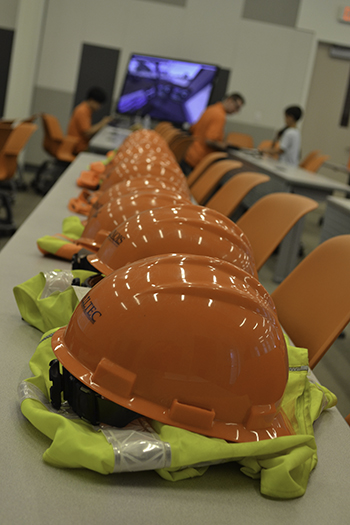
STEAMvention students were also instructed about railway safety and were able to wear official railroad personal protective equipment (PPE).
While RailTEC was created in 2010, Illinois has had a strong railroad engineering program since the latter 19th Century, “because of railways’ importance to the nation's economy,” explains Barkan. Chicago was (and is) the largest rail transportation hub in the country, so the major railways had to pass through Illinois to get there. Consequently, the rail supply industry is also concentrated in the region. “So from the earliest days, the university has had a strong academic presence in railroad engineering involving partnerships with both railroads and suppliers,” he says.
“Many of the academic leaders of the industry were faculty with expertise in railway electrical, mechanical, and civil engineering." Until the late 1930s, Illinois had a Department of Railway Engineering. It was housed in the Transportation Building, which was newly built for them in 1912. In those days, land transportation was virtually synonymous with railroads, hence the building's name.
Barkan says that, in addition to the Transportation Building, they also built a dynamometer lab.
“Do you know the only building on campus that’s not aligned with the grid?” asks Barkan. “It’s the dynamometer building. At that time, it was a state-of-the-art lab built to test locomotive power.” It is at an angle so that locomotives being tested could drive right into the lab on a spur track connecting it to the tracks of the adjacent Illinois Terminal Railroad that ran just south of Springfield Avenue (behind present day Grainger Library).

RailTEC Ph.D. student Chen-Yu Lin (left) helps a student use the simulator.
Another interesting bit of trivia: a locomotive built in the U.S. for Czar Nicholas II to haul his train across Russia was tested in the Illinois lab before being shipped to Russia.
Barkan goes on to discuss some industry pioneers at Illinois, such as Arthur Newell Talbot, for whom Talbot Lab is named. "He was unquestionably the leading academic railway civil engineer for more than three decades from the late 1890’s until the 1930’s. Talbot led a committee that studied and solved many fundamental issues regarding track structure and laid the foundation for our understanding that remains important to this day." Today, with heavier freight cars and higher train speeds, new questions derived from Talbot's pioneering work continue to be important, and RailTEC is conducting this research in their new, state-of-the-art laboratory, Research and Innovation Lab (RAIL).
Another leading railway engineering professor was William W. Hay, who taught at Illinois for more than 30 years and wrote the textbook, "Railroad Engineering" that remains the standard text in the field. Illinois had a number of other leading professors in railway mechanical engineering, electrical engineering, and railway transportation economics.

A STEAMvention student compares the weight/density of two different products: unpopped vs. popped popcorn.
Today, Illinois’ railroad engineering program is the premier program of its kind in the country. Barkan credits former dean, William Showalter, who in 1998, understood the importance of rail based on the growth of freight traffic and had the vision to see the value of rebuilding the Illinois' railroad engineering program. This move, and the university's long legacy in rail, positioned Illinois to become the leading academic rail program of the 21st century.
Barkan was hired by Showalter and then CEE Head, David Daniel, in 1998 to rebuild the rail research and educational programs. When he got here, Illinois was teaching just one rail class per year. Today, the program has grown to 12 full time employees and offers eight rail classes per year with a total enrollment of more than 150 students.
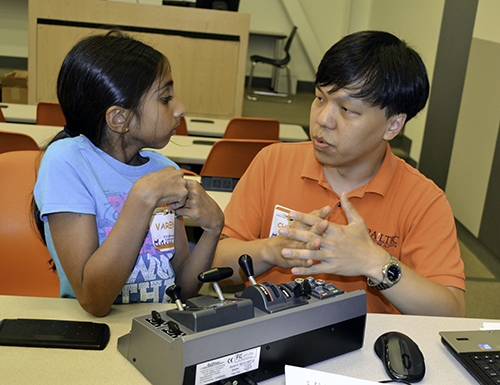
RailTEC graduate student Chen-Yu Lin (right) explains the train simulator controls to a STEAMvention student who gets to "drive" a locomotive.
While much of Illinois' rail research during Barkan's first 10 years focused on freight, that changed in 2010 with Obama's high-speed rail (HSR) initiative. "The government realized what the private sector had already learned: there were very few railway education programs in the US. Where were they going to hire people to design, build, and operate these new rail systems?” he asks. The answer of course was, Illinois!
"This is where decisions by Illinois leaders back in the 90’s helped position us ahead of the curve," says Barkan. "Most of the nation’s universities seemed unaware of the growing importance of rail until the 2010 HSR initiative. By then, we were more than a decade ahead of the rest of the academic community.” Meanwhile, the importance of rail freight and rail transit continues to expand, further contributing to the rail sector's hiring needs.
Consequently, graduates of the Illinois rail program are highly recruited. Says Barkan:
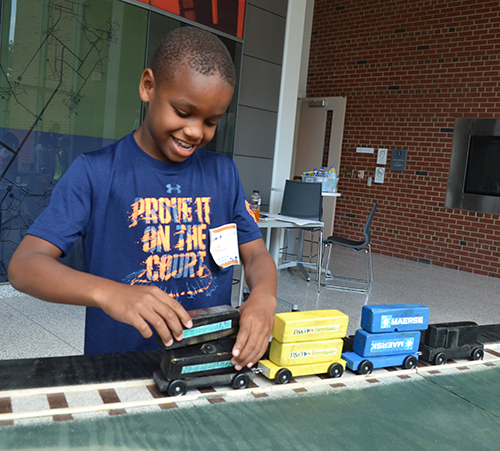
A STEAMvention student puts "cargo" onto his train during the Intermodal Game race.
"We have top quality students getting the tremendous foundational engineering knowledge that the College has to offer. Add to that their specialized education in principles of rail engineering, which is unmatched anywhere else. Graduates of the Illinois program arrive on the job with a top-notch education and quickly move up in rail organizations. We have placed hundreds of students in rail positions both domestically and internationally over the last dozen years."
But it isn’t just college students Barkan seeks to educate. On August 3, 2016, RailTEC faculty and students hosted 24 local 3rd through 5th graders from STEAMcation, a summer STEAM (Science, Techology, Engineering, ARTS, & Mathematics) program for elementary students at the Next Generation School’s STEAM Studio.
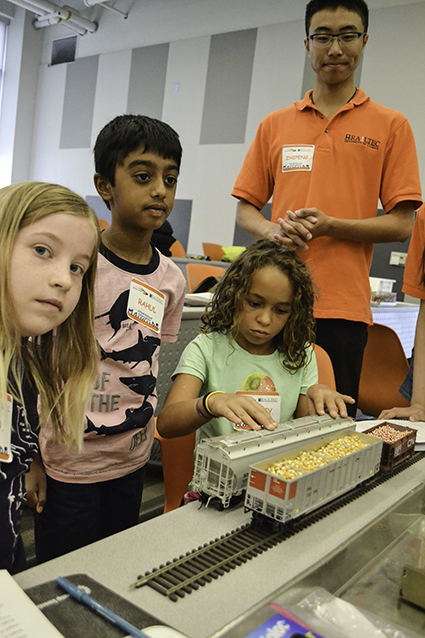
STEAMcation students explore the different types of rail cars used to carry various products with RailTEC graduate student Zhipeng Zhang (right).
Barkan and his team hope that the activities, besides being a lot of fun to do, helped to pique the kids' interest in STEM, especially railroads:
For the outreach, RailTEC faculty and students came up with numerous, creative hands-on activities related to trains that students found both fun and educational (for details about the event, please see the companion article listed below).
Barkan says he does outreach events such as the STEAMvention visit, first, “Because it’s the right thing to do,” and secondly, because of “the importance of STEM,” and the need to get more kids interested:
“I think most people involved in science and engineering are excited about their field and are eager to share their passion with students.”
“So all of us feel that we want to get more kids interested in STEM, and more kids interested in Railroad transportation. And it’s important to attract this next generation of students into this field. I got the interest from my father when I was six years old, and that’s the same experience for many of the people here, and I think it’s just a good experience for kids.”
Authors: Elizabeth Innes, Communications Specialist, I-STEM Education Initiative, with Chris Barkan, Executive Director, RailTEC. Photographer: Elizabeth Innes, Communications Specialist, I-STEM Education Initiative
For more related stories, see: Civil Engineering, K-6 Outreach, Next Generation School, STEAM Studio, 2016
For the companion article about STEAMcation at RailTEC, see:
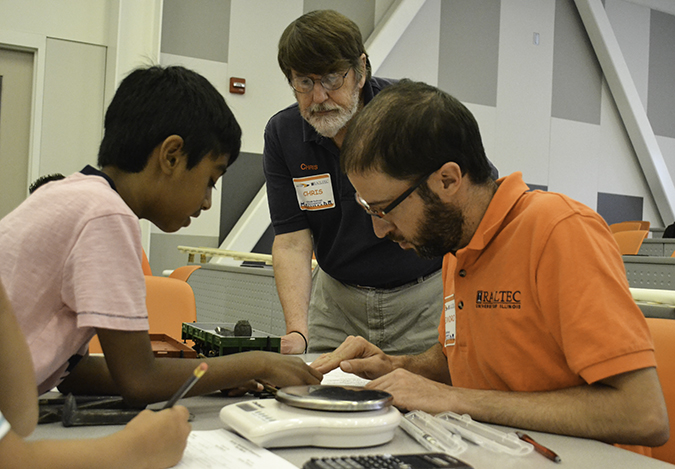
RailTEC Executive Director Chris Barkan watches as grad student Alejandro Reyes (right) teaches a STEAMcation student about roller resistance during STEAMvention 2016.
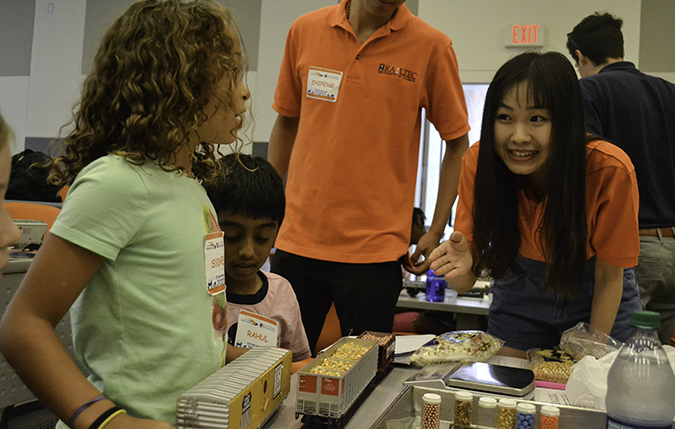
RailTEC graduate student Lijun Zhang (right) explains about the types of rail cars used to carry various products.













.jpg)
















